2023 IATI Budgets Analysis
Looking ahead in 2023, how can data users leverage IATI budget data to assess the global development and humanitarian aid landscape?
As the first quarter of 2023 draws to a close, how can users access the real-time availability of IATI ‘budget’ data to analyse the trajectory of the global aid landscape for the rest of the year? Users of IATI data commonly need information on the resources that are projected to be spent in the future. This information enables actors in both development and humanitarian spaces to better plan and coordinate.
IATI budget data also gives users the ability to critically assess shifts in the global funding landscape while pinpointing any data gaps. For example, what does the IATI budget data tell us about the global outlook for the emergency response sector in 2023? Or as a more granular example, is Turkey now projected to be a major recipient country of external resources in the aftermath of the devastating earthquakes in February? Or more critically, how can we compare 2022 budget and spending data to test the completeness of the budget data available for 2023? Or even, which organisations are not publishing budget data at all?
The purpose of this article is to demonstrate the kind of analysis that can be carried out using just one of IATI’s data access tools, the Country Development Finance Data (CDFD) tool. It presents ways in which users can assess and compare resources projected to be spent in 2023 (budgets) and the kind of preliminary conclusions that can be drawn about the global aid landscape in 2023.
What is budget data and how is it useful for different data users?
A ‘budget’ is reported to IATI in periods (with a start and end date) at the activity level. The purpose for publishing budget data is to provide predictability for planning and coordination. Organisations can publish budgets in different periods (e.g. month, quarter, year) but in CDFD, budgets are aggregated into quarters. For example, where budgets span more than one quarter, the total budget value is split proportionally into quarters. If a budget does not perfectly span quarters, but instead spans partial quarters, the number of days in that partial quarter are used to calculate the proportion of the value to be attributed to each quarter.
Budget data is particularly useful for a range of different stakeholders to analyse information on the projected inflows of external resources flowing into a recipient country. These, include the following:
For development partners:
- Enables improved understanding of ways in which fellow organisations are planning to allocate resources, and it should enable partners to better coordinate to reduce duplication, ensure that resources are being allocated in line with Government priorities, and provide necessary information to ensure that there is a match between a country’s needs and the allocation of resources.
For civil society:
- Enables understanding of what activities are planned for the upcoming year and how partners are expecting to spend resources. It enables civil society to monitor progress and ensure partners and governments are delivering as promised; to better coordinate with other organisations; and to identify potential funding opportunities.
For governments:
- External finance complements national resources; therefore, information on projected inflows is essential for planning national budgets. Knowing how external finance is to be allocated and spent informs the ways in which Governments allocate their national resources. To be most useful as an input, this information is needed prior to the start of a government’s fiscal year, disaggregated by quarter, and for the upcoming 3 years.
Analysing IATI budget data for 2023
With the IATI data that can be accessed using CDFD, users can look at budgets to comparatively assess the planned trajectory of activities, which can provide insight into changes in the global development/humanitarian landscape. In this way, comparative analysis of budgets can provide critical information needed to forecast where resources are projected to be spent - by recipient country, reporting organisation, and/or down to the sectoral level.
The graphs provided below, generated from data downloaded from CDFD, are a few different examples of how the 2023 budget data can be analysed. For example, Graph 1 (Budgets by Recipient Country – 2023) shows how India is projected to receive over USD $13 billion, by far the most projected for a recipient country so far in 2023. Ukraine and Turkey follow next with USD $8 billion and USD $7 billion of resources expected to be spent in both countries, respectively in 2023. It is worth noting the substantial increase of budgeted resources for Turkey as the third largest recipient country (in comparison to the USD $4.2 billion budgeted in 2022). Given the scale of the emergency relief effort in the wake of February’s devastating earthquakes, this result may be unsurprising; nevertheless, the data published in IATI provides evidence to help validate the assumption that relief efforts towards Turkey’s disaster response have prompted a shift in the provider funding landscape towards the country.
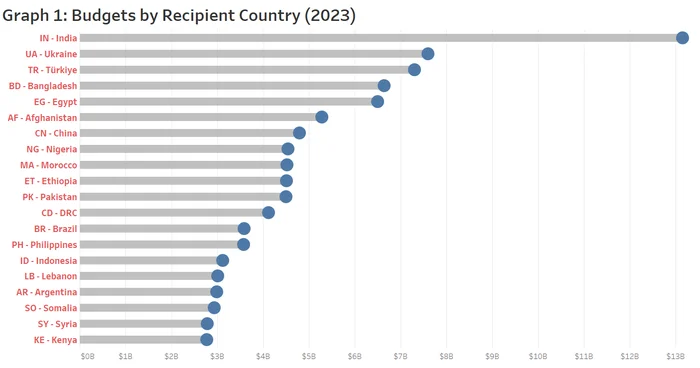
Graph 1: Budgets by Recipient Country (2023)
To explore 2023 budgets by recipient country in CDFD (with up-to-date data), click here (Dashboard) or here (Custom Data Download).
IATI budget data can also be used to analyse where resource flows are being channeled at the sector level. The sector category (e.g., 720 – Emergency Response) is based on the OECD (Organisation for Economic Cooperation and Development) DAC 3-digit code list for sectors. As Graph 2 (Budgets by Sector – 2023) illustrates below, the Emergency Response sector is projected to receive the largest portion of resources in 2023 with over USD $24 billion; the Energy sector the second largest, with a projected budget of USD $18 billion; and the Health sector expecting USD $17 billion in 2023.
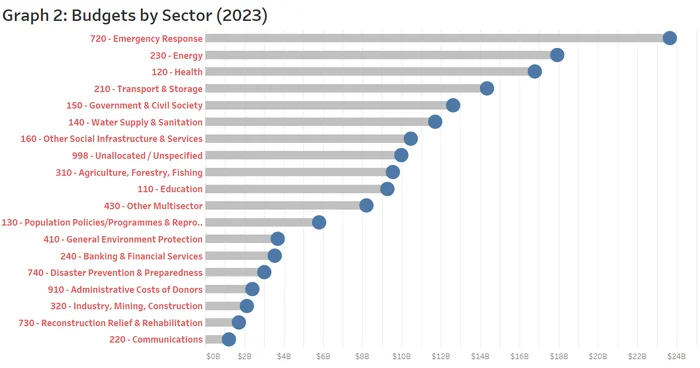
Graph 2: Budgets by sector (2023)
To explore 2023 budgets by sector in CDFD (with up to date data), click here (Dashboard) or here (Custom Data Download).
If we drill down the Emergency Response sector further, Graph 3 (Emergency Response Sector: Projected Global Landscape in 2023) maps the budgeted resource allocations by recipient country for the sector. According to the mapping, Afghanistan, Syria, Somalia, and Ukraine are expected to receive the lion’s share of global resources earmarked for the Emergency Response sector overall.
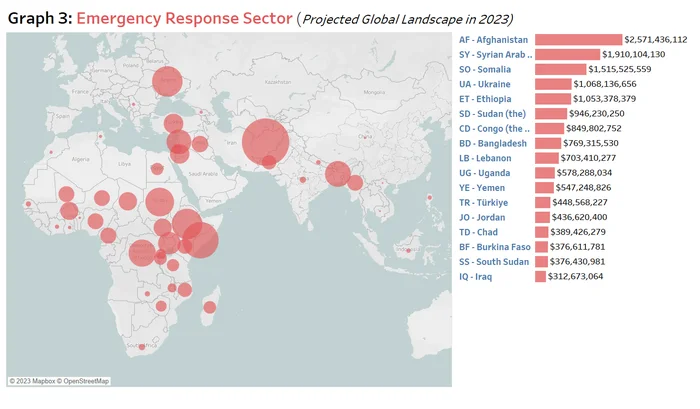
Graph 3: Emergency Response Sector: Projected Global Landscape in 2023
To explore 2023 budgets for the Emergency Response sector in CDFD (with up-to-date data), click here.
IATI Budget Comparison (2022 vs 2023): Considerations for data users
While there is already a great deal of budget data published in IATI, there is room for improvement. As of 1 March 2023, only one third of IATI publishers are publishing budget data.
In addition, organisations publish their budget (and spending) in IATI according to varying timelines (e.g. monthly, quarterly, annually) which means that the completeness of the data depends on when the data is retrieved. As an example, we can use the 2022 budget and spend data available in CDFD to test the completeness of the budget data available for 2023. In Graph 4 (Budgets vs. Spending by Recipient Country – 2022), it can be seen that budgeted resources (and actual spending) to recipient countries was dwarfed by the war in Ukraine in 2022 with a substantial budget of over USD $17.5 billion, outpaced by actual spending (USD $21 billion) within the same year. As Russia’s invasion into Ukraine continues to have far-reaching consequences across the globe, budgeted levels for Ukraine (for example) are likely to be substantially higher when reporting organisations update their budget data later this year.
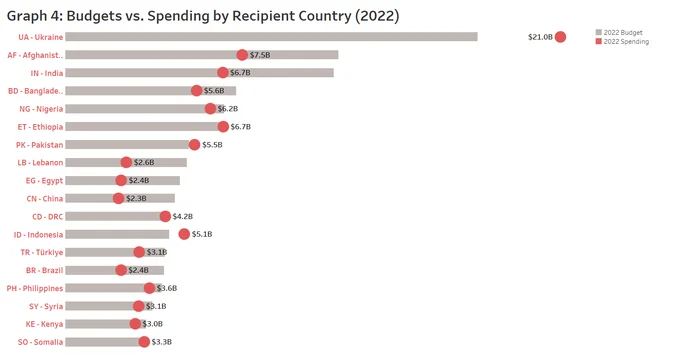
Graph 4: Budgets vs. Spending by Recipient Country (2022)
If we also look at the variation in IATI budget data published for 2022 compared to 2023, (Graph 5: Comparing Budgets by Recipient Country – 2022 vs 2023) we can anticipate an increase in budgets for Ukraine and Afghanistan, as organisations update their activities in 2023. In addition, it is worth highlighting the elevated budget level for Turkey planned for this year in comparison to 2022, with over USD $7.3 billion projected to be spent in 2023, further confirming the shift in provider funding towards the country following the devastating February this year.
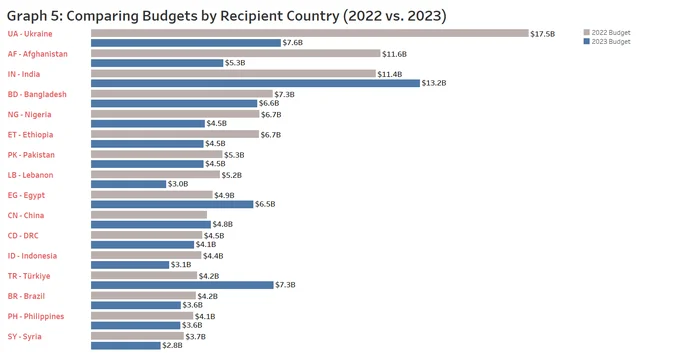
Graph 5: Comparing Budgets by Recipient Country (2022 vs 2023)
Notwithstanding the timeliness of publishing forwarding-looking budgets, some major providers of development and humanitarian assistance do not publish budget projection data to IATI, which can present an obstacle for users looking to understand the complete picture of the global aid landscape. Take for example, the analysis presented in Graph 6 (Budgets vs. Spending by Reporting Organisation – 2022). While the U.S. Government reported by far the most spending to IATI in 2022 with over USD $44.5 billion, the U.S. did not record any information on forward-looking budgets throughout last year.
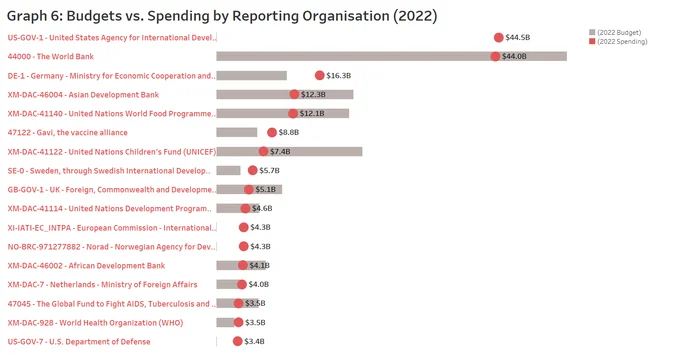
Graph 6: Budgets vs. Spending by Reporting Organisation (2022)
The lack of availability of budget data from major providers (for example, the U.S. and the European Commission) poses a substantial obstacle to conducting a full 2023 budget analysis. The burden is thereby placed on the data user to decipher previous spending transactions from the previous year to reconcile any estimates to fill the gaps. In conclusion, reporting organisations should strive to publish forward-looking budgets in IATI as early in the reporting year as possible to enable actors in both the development and humanitarian spaces to better plan and coordinate.
Other resources for accessing and analysing budget and spending data in IATI
Using the Country Development Finance Data tool, access data on development and humanitarian activities, presented simply by country, reporting organisation and sector. Visualise or download the data for easy analysis.
Data Dashboards: Visualise the data in useful summary maps, charts, and tables. Explore a summary dashboard as well as dashboards presented by Country/Region, Reporting Organisation, and Sector. Use various filters to customise your view.
Custom Data Downloads: View and download customised spreadsheets of data using a range of filters to select the data you need based on your interest. Select the columns to be included in your spreadsheet and filter it by calendar year or quarter, budgets and/or spending, reporting organisation, type of aid (e.g. grant or loan) and more. Also check out our recent webinar demoing the data dashboards and custom data downloads.
CDFD instructional videos (available in English, French, Spanish and Portuguese):
- Part 1: CDFD How to access IATI data
- Part 2: CDFD How to analyse IATI data
Connect with fellow data users
- Connect with fellow data users on Data Use Community of Practice on IATI Connect, IATI’s digital community platform.
- Check out the updated Data Use Query Corner on IATI Connect; this space is a one stop location where data users can learn to solve queries with IATI data, and ask the Community their questions and discover the latest opportunities to engage with one another
Reach out directly to the IATI Secretariat at [email protected] for additional support in accessing, understanding or analysing IATI data.
This analysis has been provided by the IATI Secretariat and was undertaken by Cody Wallace, IATI Project Management and Data Use Analyst at UNDP.